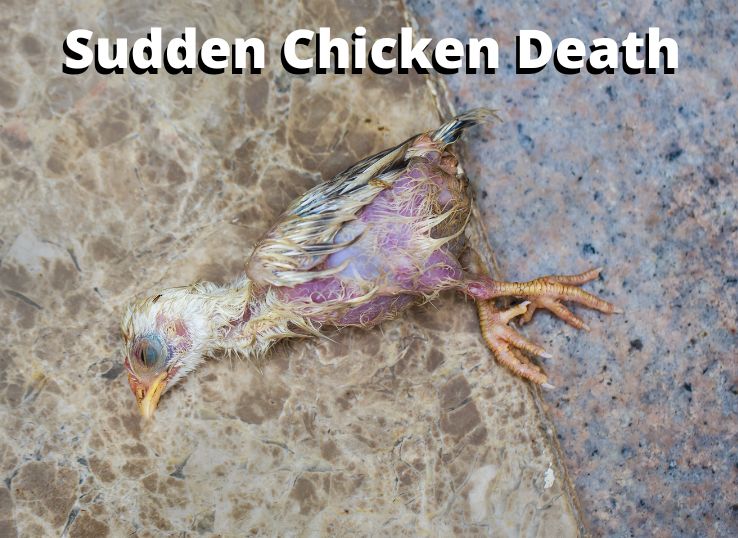Last Updated on June 22, 2023

Sudden deaths in the members of your chicken flock is a tragic and overwhelming experience. Sudden Chicken Death Syndrome is etiologically uncertain and occurs mainly due to metabolic disorders. Without any premonitory signs, these disorders cause cardiac arrhythmias in chickens.
Sudden Chicken Death Syndrome is more likely to occur in fast-growing chickens. If you’re rearing meat-purpose breeds or broilers on an intensive system, SCDS can cause sudden deaths. A study has shown that male chickens are 60% to 80% more predisposed to this syndrome.
As a veterinarian, I’ve encountered Sudden Chicken Death Syndrome on many commercial farms. The strange and unexplained way of death has many causes that induce SCDS. Although there are many other life-threatening diseases, SCD Syndrome is always a matter of concern.
The recent statistical analysis of Sudden Chicken Death Syndrome shows a prevalence of 0.5% to 4%. The incidence rate of this syndrome is more in young chickens. According to research analysis, the incidence rate is found to be 1% to 4% in young broiler chicks.
Sudden Chicken Death Syndrome has no apparent signs overall. Getting to know what factors are involved, is of equal importance for every chicken owner. I am here to address SCDS and if there is any way you can reduce the incidence of Sudden Chicken Death Syndrome in flocks.
Table of Contents
ToggleWhat is Sudden Chicken Death Syndrome?
Sudden Chicken Death Syndrome is something you should be worried about depending on its prevalence. This syndrome is present worldwide leading to short and terminal wing beating convulsions in chickens.
Many veterinarians and scientists are baffled about how this syndrome causes mortality in chickens. SCDS is seen to cause cardiac arrhythmias related to multiple things going wrong with the metabolism. The arrhythmias and convulsions lead to suddenly flipping over and dying without any warning signs.
Another study on the susceptibility of SCDS in chicken breeds reveals something worth noticing. The statistics show that rapidly growing broiler breeds are more likely to experience SCDS. In contrast to the broilers with 27% SCDS prevalence, leghorns and other layers have only 1%.
From genetic factors to stress, anything that causes abnormal alterations in metabolism is linked to SCDS. Sudden Chicken Death Syndrome is also thought to be linked with high growth rates. The low-density feed makes chickens more prone to it during the first 3 weeks of life.
Causes of Sudden Chicken Death Syndrome
No matter how much you care for your chickens, there are times when you cannot stop SCDS. As I’ve mentioned above, fast-growing broiler breeds are more prone to it. Many pieces of research are indicative of metabolic disturbances as the origin of Sudden Chicken Death Syndrome.
High-Energy Diets
On a commercial level, broiler chickens are fed high-protein and glucose diets. This is usually done to meet the needs of fast-growing broilers. To put on the weight faster, these diets help but these also induce stress and strains on the bodies of chickens.
Sudden death is mainly linked to the use of such feeds and cardiovascular issues. Poor-quality diets also put stress on the metabolism of chickens. The effects produced by these metabolic disturbances are mainly on the cardiovascular and nervous systems of chickens.
The rapid growth rates coupled with such diets and stress are the main culprit of the flip-over syndrome. The severe changes that result from such problems lead to convulsions and cardiac arrhythmias. Sudden effects in cardiac functions cause ventricular fibrillation and cardiac failure.
Inactivity in Broiler Breeds
The breeding plans of broiler chickens are mainly focused on high growth rates and weight gain. This does benefit the basis of the profitability of the farm but makes these breeds inactive. If you happen to visit a broiler farm, you’ll notice their negligible physical activity.
Inactivity and lethargy lead also put an impact on the overall chicken metabolism. The increase in fat deposition in the muscles and blood vessels put a strain on the heart of chickens. Consequently, broiler breeds experience more heart issues leading to Sudden Chicken Death Syndrome.
Lighting & Farm Mismanagement
The reproductive cyclicity of chickens is determined by the influence of light durations. The same goes for weight gain in broiler chickens. In a commercial setting especially in environmentally controlled sheds, chickens are unable to get the natural light from the sun.
Exposure to artificial light increases egg or meat production in chickens. At the same time, this can overexert the bodies of chickens. Sudden Chicken Death Syndrome has more chances in these circumstances leading to sudden mortality in chickens.
Signs of Sudden Chicken Death Syndrome
You may observe your chickens hanging around totally normal in terms of feeding and other activities. Sudden Chicken Death Syndrome presents no abnormal premonitory signs at the start. But, some signs start to get evident once the syndrome reaches its advanced stage.
Cardiovascular irregularities and nervous signs start appearing near death. Chickens may have their necks extended and show difficult open-mouth breathing. You may experience open-mouth respiration along with gasping and squawking.
Within a short period of the initial attack, the wing beating is shown with irregular leg movements and paddling. Eventually, the cardiac arrhythmias and convulsions make the chickens flip on their backs and die.
Sudden Chicken Death Syndrome is more prevalent in young age chicks. This syndrome can occur at any age but starts as early as the chicks are seven days old. The highest mortality chances ever recorded is between the age of 12 to 28 days.
Most chickens experience per-acute death within a short time. On the other hand, there are no gross lesions to differentiate if the death is due to SCDS or some other disease. Moreover, postmortem examination yields minimal data about this syndrome.

Managing Sudden Chicken Death Syndrome
Many types of research are currently in progress to lessen the impact of Sudden Chicken Death Syndrome. However, some changes can make your chickens less prone to this syndrome.
One of the major contributing factors is the high-energy diet. Broilers do require such feeds but a well-rounded feed can be helpful. You should always use high-quality feeds which ultimately lowers metabolic dysfunctions.
One research indicates the use of oils in the feed can incorporate good fatty acids into the blood. The reduction in cardiovascular effects by adding sunflower seeds provides benefits to your chickens. Our ultimate goal is to reduce the growth rate by controlling nutrient intake.
During the early life stages, you’re more likely to experience mortality in your flock. For the first 3 weeks of life, use a feed that has a low amount of glucose and nutrients. The energy density and protein levels should be adjusted to minimum levels depending on the growth stage.
Well, chickens don’t reduce the intake of feed on their own. One of the ways you can accomplish this is through the reduction in light exposure periods. Less number of lights per day tricks a chicken’s brain into only eating feed during the light duration.
Consequently, the chickens prefer to rest and stop feeding during dark hours. I address two major ways through which you can reduce nutrient intake if the issue of SCDS is prevailing at your farm. Removing or reducing the causes of SCDS is the only way you can achieve low mortality rates.
Final Thoughts
Sudden Chicken Death Syndrome is a serious problem with no prominent signs in chickens. I know it is intimidating to add new chickens after the loss of your flock. However, these beloved chickens must be kept with great care and management.
Knowing about the possible causes such as low-quality feed and mismanaged light can help a lot in SCDS. Managing chickens, especially at an early age is of prime importance. If your chickens are experiencing signs of Sudden Chicken Death Syndrome, you need to watch out for the causes.
With that being said, Sudden Chicken Death Syndrome can be prevented or at least minimized by following expert guidelines. Keep in mind that SCDS can occur at any age. Following the best feed & managemental practices can save your chickens from Sudden Chicken Death Syndrome.
Research References
Siddiqui, M. F. M. F., et al. “Sudden death syndrome–an overview.” Veterinary World 2.11 (2009): 444-447.
Olkowski, A. A., et al. “A study on the pathogenesis of sudden death syndrome in broiler chickens.” Research in veterinary science 85.1 (2008): 131-140.
Imaeda, N. “Influence of the stocking density and rearing season on incidence of sudden death syndrome in broiler chickens.” Poultry Science 79.2 (2000): 201-204.

I am a Veterinarian by profession having 3 years of experience in raising poultry flocks. So far my number of successful flocks is 9. I am sharing all my experience about poultry farming with you so that you can make this profession your bread and butter. Stay Tuned with my latest post.
